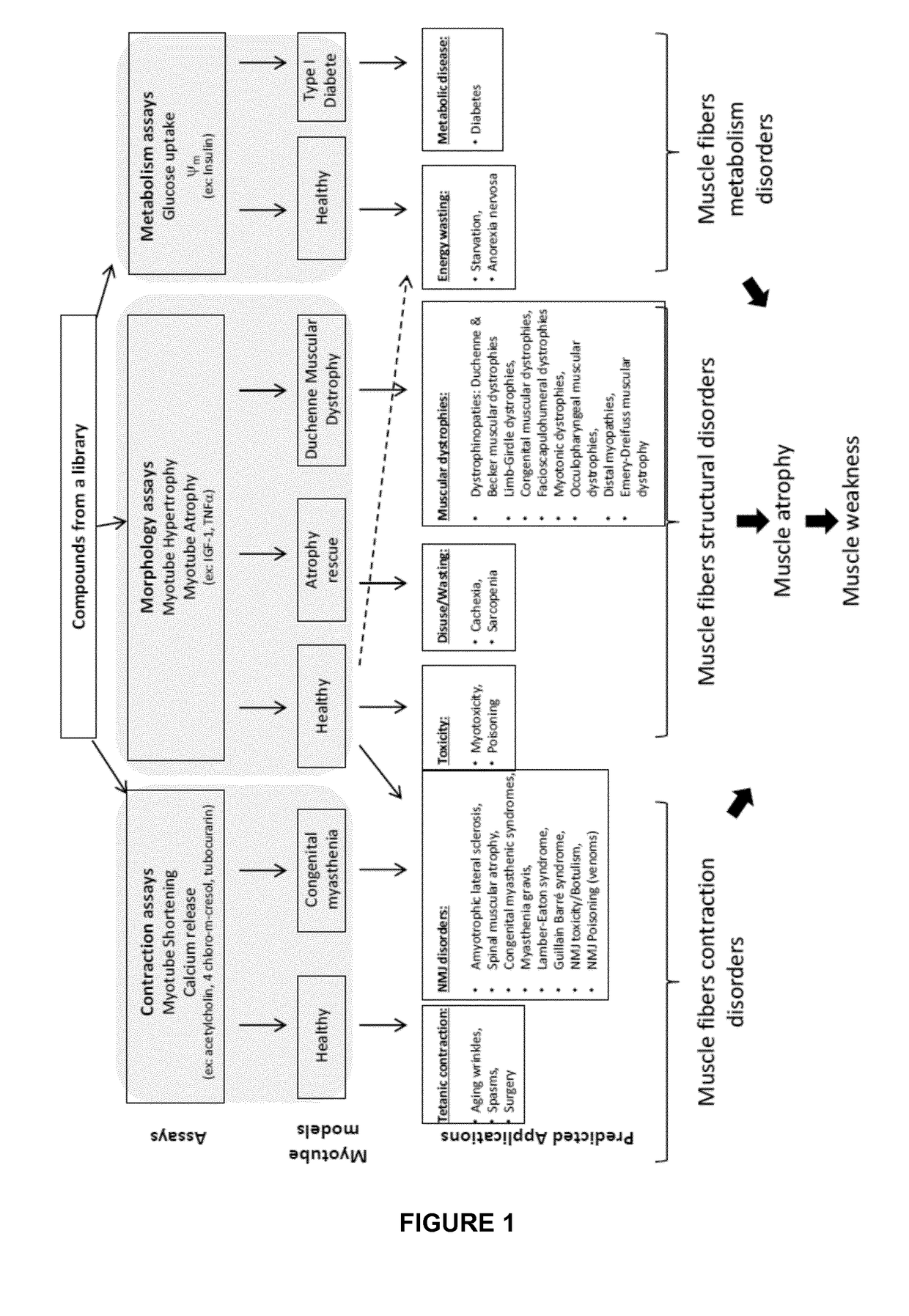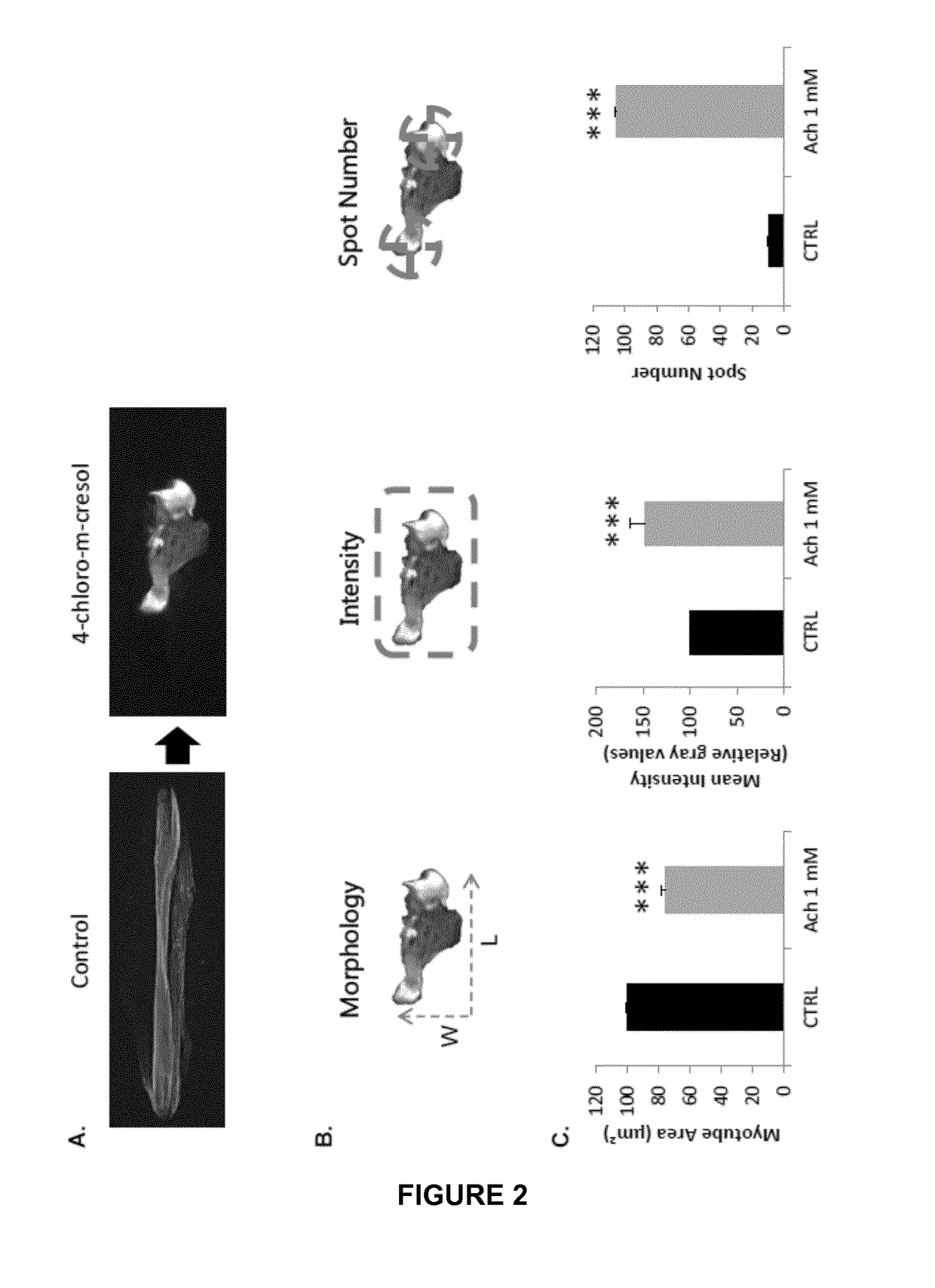High throughput and functional screening method for muscle related disorders and biological processes
a functional screening and muscle technology, applied in the direction of biological material analysis, material analysis, instruments, etc., can solve the problems of muscle weakness, loss of muscle mass, and indirect muscle loss in patients,
- Summary
- Abstract
- Description
- Claims
- Application Information
AI Technical Summary
Benefits of technology
Problems solved by technology
Method used
Image
Examples
first embodiment
[0063] the invention provides a method for screening compounds using cell based assays allowing the detection of drugs impacting muscle contraction disorders.
[0064]This method may comprise, in myotube culture step, adding at least one inhibitor of muscle contraction, or performing a genetic modification, to mimic neuromuscular disease, poisoning, or muscular genetic disease.
[0065]In particular, compounds affecting the contraction of myotubes especially from healthy donors are predicted to be candidates as new treatments for tetanic related disorders, as muscle relaxants for surgery, anti-spasmodics, and anti-wrinkles.
[0066]A high throughput cell based assay is designed to assess compounds effect on muscle contraction through estimating myotube shortening and calcium release.
[0067]By “myotube shortening” is meant myotube becoming shorter in area due to a compound treatment.
[0068]By “calcium release” is meant calcium ions entry within myotube cytoplasm due to a compound treatment.
[006...
second embodiment
[0074] the invention provides a method for screening compounds using cell based assays allowing the detection of drugs impacting myotube morphology.
[0075]This method may comprise, in myotube culture step, adding at least one muscle atrophic inducer, or performing a genetic modification, to said culture to mimic muscle wasting, disuse, or muscular genetic disease.
[0076]In particular, compounds affecting myotube morphology from healthy donors are predicted to be muscle toxic compounds.
[0077]By muscle toxic is meant in the present text the effect of a compound on myoblasts differentiation, myotube maturation, myotube hypertrophy, myotube atrophy, cell viability or creatine kinase release.
[0078]By myotube maturation, it means the number of nuclei within myotubes, the rate of myotubes with aligned nuclei, the expression of maturation markers (SERCA1, RyR1, triadin, Troponin T, α-actinin, myosin heavy chain), the rate of myotubes with a respective localization of said biomarkers comparabl...
third embodiment
[0095] the invention provides a method for screening compounds using cell based assays allowing the detection of drugs impacting muscle metabolic disorders.
[0096]This method may comprise, in myotube culture step, adding at least one inhibitor of muscle metabolism, or performing a genetic modification, to said culture to mimic metabolism disease, or muscular genetic disease.
[0097]In particular, compounds enhancing myotube metabolism from healthy donors or type I diabetic donors are predicted to be cures for diabetes and to counteract the energy wasting syndrome due to for example anorexia nervosa or a deep starvation.
[0098]Human primary myoblasts from a healthy or a type I diabetic donor, are cultured on fibronectin coated surfaces within growth medium during 24 hours. Then cells are cultured within differentiation medium (DMEM / F12, 2% Horse Serum, 0.5% P / S) for 24 hours. Therapeutic drug candidates are added and myotubes are then cultured during 96 hours. Compound effect on glucose ...
PUM
| Property | Measurement | Unit |
|---|---|---|
| Young's modulus | aaaaa | aaaaa |
| Young's modulus | aaaaa | aaaaa |
| time course experiments | aaaaa | aaaaa |
Abstract
Description
Claims
Application Information
 Login to View More
Login to View More - R&D
- Intellectual Property
- Life Sciences
- Materials
- Tech Scout
- Unparalleled Data Quality
- Higher Quality Content
- 60% Fewer Hallucinations
Browse by: Latest US Patents, China's latest patents, Technical Efficacy Thesaurus, Application Domain, Technology Topic, Popular Technical Reports.
© 2025 PatSnap. All rights reserved.Legal|Privacy policy|Modern Slavery Act Transparency Statement|Sitemap|About US| Contact US: help@patsnap.com



